Whether you call it fluid art, flow art, liquid art, pour painting or acrylic pouring, chances are good that you’ve come across this art form once or twice while scrolling through Facebook! pour painting is where an artist mixes acrylic paints and pour them onto your canvas or other surfaces creating abstract designs. Paint pouring is a subset of acrylic painting and also a fluid art (including alcohol ink and resin art). Many artists learn paint pouring along with other techniques and combine them to create incredible pieces of work.
In this guide you will learn what paint pouring is, how it began, what supplies you need to start, and a step by step tutorial for your first pour. Let’s get started!
What Is Acrylic Pour Painting?
Pour painting (also is the act of mixing acrylic paints with a flow enhancer (like Floetrol) and pouring it onto a surface to create abstract swirls and designs. Abstraction and a love for the mixing and mingling of colors really sits at the heart of pour painting, and the dance that each color performs on the artist’s desired surface is surely what attracts most beginners!
Why Should I Start Pour Painting?
Pour Painting is the perfect art form to start with as a new or aspiring artist for a few reasons:
- Paint pouring is a very accessible. One does not need to be an artist, have received professional training, or even picked up a paint brush to begin creating art with this technique. You’ll just need the info in this post and supplies and you’ll be ready to get going!
- Beginners can see positive results and success quickly. Creating art can be a mental hurdle for some as they find it hard to express themselves, and many beginner (and advanced) artists are overly critical of their work to the point of discouragement. With pour painting absolute beginner artists can still create beautiful pieces that inspire them and others relatively quickly compared to more realistic focused art forms like sketching, or watercolors.
- Pour painting is a great stress relief and is fun! Paint pouring offers a medium that is forgiving and beautiful. The process itself is cathartic as the paint flows across the canvas and gentle tilting creates new shapes and designs. Just watch some YouTube videos of pouring and you’ll already start to feel the relaxation the technique brings. Many people do pour painting just for this purpose and don’t care about the results nearly as much as the relaxation the process brings.
- Pour painting can help artists learn color theory before moving on to other techniques. When learning to paint realistically you have to learn form, color, medium, lighting, shading etc. and apply all the techniques at once. This can be difficult and take a long time. With acrylic pouring you can isolate color related skills and learn how to use colors in interesting ways to see immediate results rather than needing to master all the skills at once.
The advanced artist can also benefit from paint pouring. Pours lend themselves beautifully to dreamy, surreal backgrounds for skilled artists to paint realistic scenes on top of (like the owl below by Brenda Bennett). Acrylic pouring is so versatile, that artists can easily incorporate it into pieces to amplify their work.
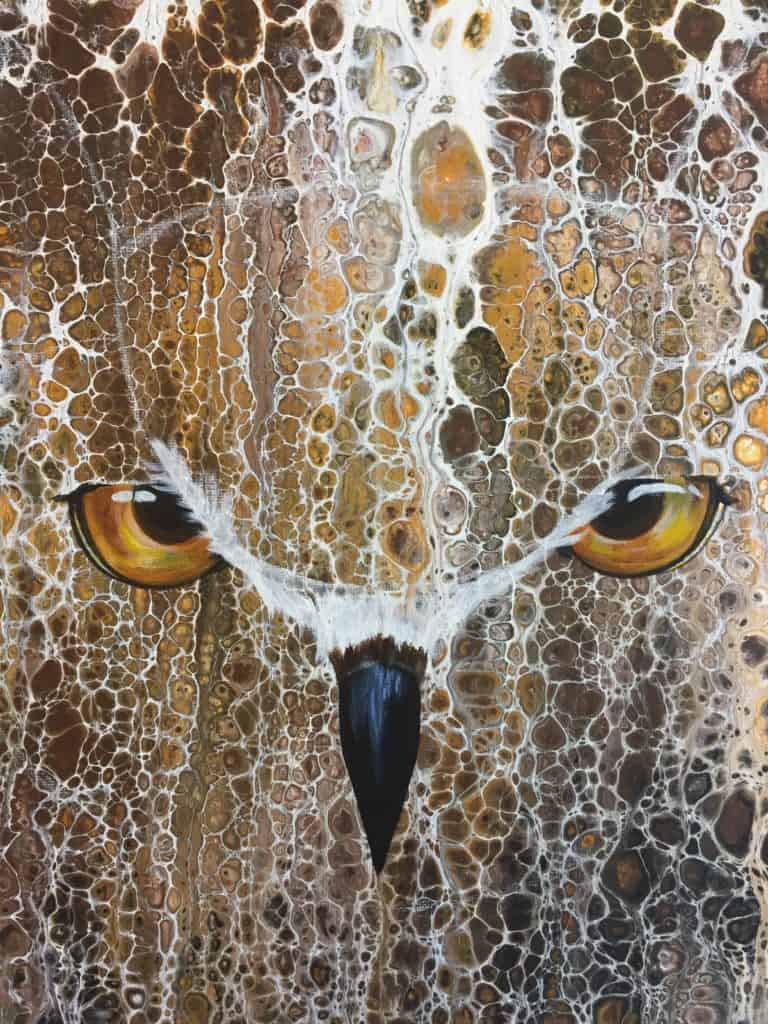
Accidental Beginnings of Paint Pouring
According to physicscentral.com, the first person to really discover fluid art was an artist named David Alfaro Siqueiros in the 1930s. David was fascinated by the simple act of pouring colors onto a surface, and how intricate the result was. Other artists experimented with the same technique, playing with different paint consistencies and mixatives.
Fluid art is “simple” in that the mixing of paint and medium rarely changes; acrylic paint and a flow enhancer are combined in essentially the same ratios for many of the different acrylic pouring techniques. Where the intricacy and skill come in is when the paint colors are chosen, since an artist must have a basic understanding of the color wheel, and when the paint is actually poured, and the artist must make decisions on how to manipulate the paint to create the best effect.
Realistically, abstract art has been captivating people since 1910, when the “Father of Abstract Art”, Wassily Kandinksy, began creating art as he listened to music. He could visualize the colors of the music notes, a result of a neurological condition called synaesthesia. He painted the music and abstract art was begun. In the 1940s, the Abstract Expressionism Movement brought abstract art to the masses, and the idea of creating a piece that could be interpreted a different way by each view was born.
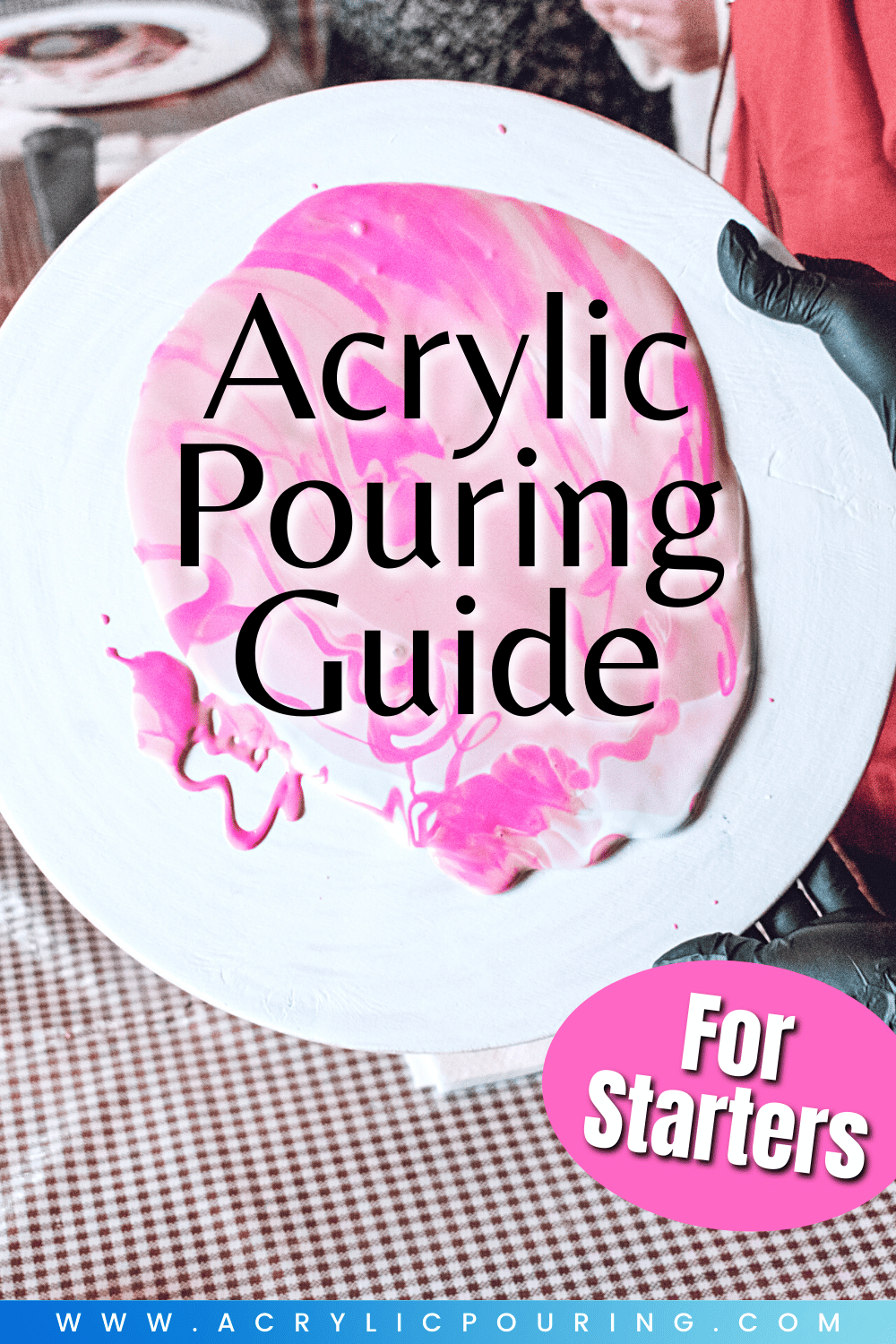
The real draw of pour painting and abstract art, in general, is the joy of watching how the colors and patterns evolve and dance with each other on the canvas. Aside from being accessible for artists-one does not need any formal artistic education or any prior experience-abstract art and paint pouring is also accessible to the viewer. In our Facebook group alone we have over 90,000 members and regularly they comment on seeing seen faces, dragons, horses, and other animals and shapes in their projects. Members post their paintings and say what they see, and other members chime in with something completely different! It’s truly amazing to watch.
On a side note, to complement your Acrylic Pours, I highly recommend using a Cricut Machine (my personal favourite is the Explore Air 2 machine) to design and print yourself beautiful crafts on all sort of supports. Check it out here! Now back to an overview of Paint Pouring Techniques.
An Overview of Paint Pouring Techniques
There are many different techniques that an artist can use when pouring paint. Some techniques are better for a beginner, while other techniques require a more advanced understanding of color theory and paint movement.
Beginner Techniques
Here are a few of the beginner techniques that are great for first-time or practicing fluid artists:
- Basic, Clean, or Straight Pour: the process of pouring individual colors on a surface and manipulating them either by tilting or by swiping over them to create patterns and blends.
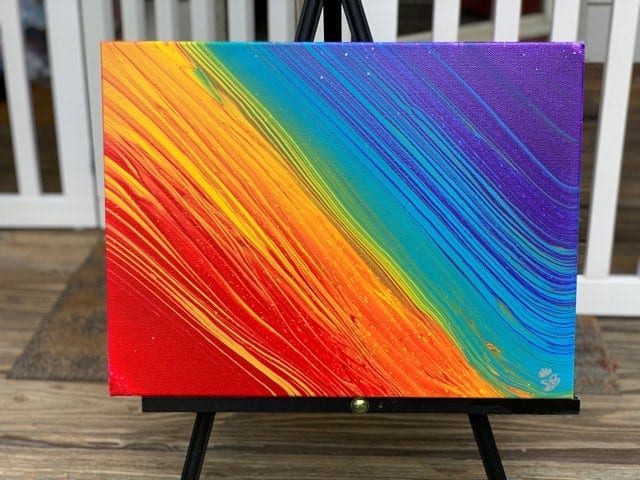
- Dirty Pour: the process of layering individual colors in a cup, and then pouring them onto a surface altogether instead of separately.
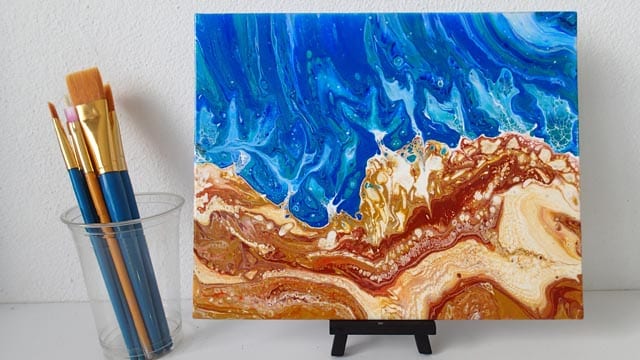
- Flip Cup: a process that uses the dirty pour layering technique, except the cup is flipped upside down onto the surface and then pulled up quickly or punctured to release the paint.
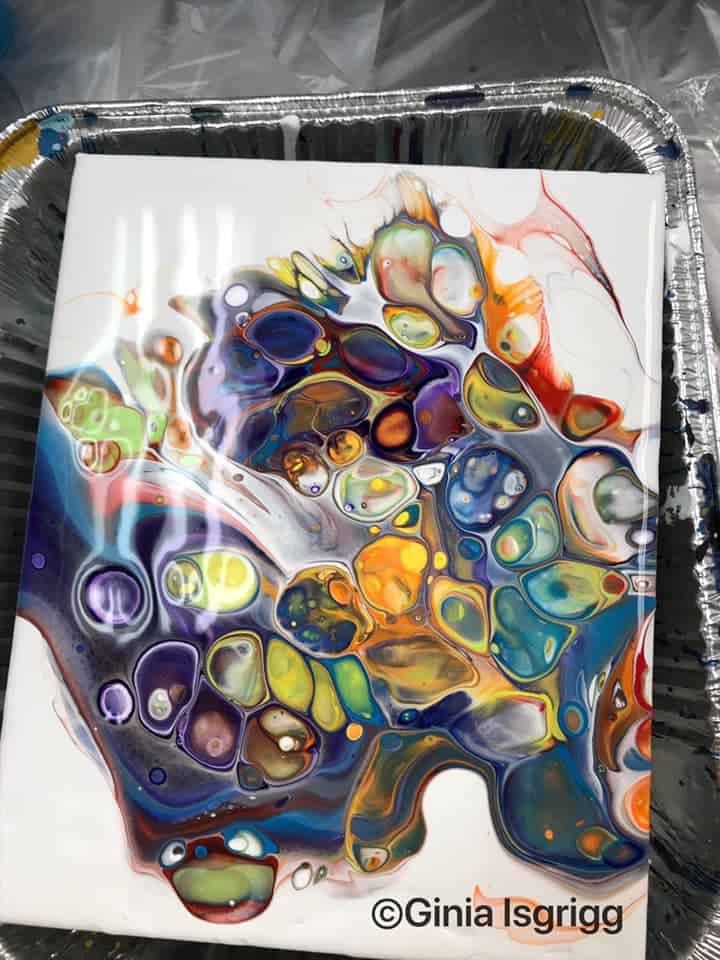
- Puddle Pour: a process that uses the dirty pour layering technique, and the paint is poured all in one puddle on the canvas instead of poured all over it.

- Tree Ring Pour: paint is layered in a cup similar to the dirty pour technique, and then poured on the canvas in repetitive tight, controlled circles to form a ring pattern.

Paint Pouring Supplies
Supplies for paint pouring will vary in price depending on the quality that you purchase. When you’re first starting out, it’s recommended that you use craft acrylics which are significantly less expensive than professional level artist acrylics; that way, you can feel free to experiment without the stress of “wasting” expensive materials should you not like the result. If you’re interested in a more comprehensive overview of supplies, check out our paint pouring supplies guide.
Pouring Paints
Acrylic paint is comprised of pigment suspended in an acrylic polymer emulsion. It dries very quickly compared to oil paints, and is water soluble. Acrylic paint is extremely versatile in that it can be combined with various mediums and gels to create all sorts of textures and viscosity. By adding a flow enhancer like Floetrol or Liquitex Pouring Medium or even water, acrylic paint becomes thinner and flows easily over surfaces.
To begin you’ll probably want a craft acrylics set along with some extra black and white paint we’ve listed below.
Craft Acrylics (Beginners Pick one set and add extra black and white)
- Apple Barrel Acrylic Paint Set, 18 Piece (2-Ounce)
- Sargent Art 8-Ounce Acrylic Paint, 12 Piece Set
- Sargent Art 16-Ounce Acrylic Paint, White
- Sargent Art 16-Ounce Acrylic Paint, Black
Professional acrylics
- Golden Fluid Acrylic Set Of 10
- Liquitex Professional Heavy Body Acrylic Paint Set of 12
- Golden High Flow Acrylic Paint, 16 Ounce, Carbon Black
- Golden High Flow Acrylic Paint, 16 Ounce, Titanium White
Paint Pouring Medium/Flow Enhancers (Beginners pick one to try)
Pouring medium and/or flow enhancers are available from many different companies, and it seems like every fluid artist has a favorite! We have some basic medium info below, but if you’re looking for more then check out our comprehensive paint pouring medium guide.
- Floetrol: Floetrol is one of the most popular and most affordable pouring mediums on the market. Floetrol is a latex paint additive that improves the flow and levelling of water-based paints (like acrylic paint). It’s widely available at most hardware stores that sell house paint, and can also be purchased online. For more info see our Floetrol guide.
- Liquitex Pouring Medium: Liquitex Pouring Medium is also a popular medium, and is considered a professional medium. Liquitex provides a high-gloss, wet-look finish and helps to maintain color. Liquitex is recommend for use at a rate of 5% medium to 95% paint (of course, this will also depend on the type of paint you’re using).
- Golden Color Pouring Medium: Golden is a reputable brand, and is also considered a professional medium. Golden makes two mediums specific to pouring: a gloss finish, and a matte finish. Golden recommends using their medium at a rate of 10 parts medium to 1 part acrylic color-again, this will depend on what paint you’re using.
- Water: If you’re on a budget, you can use water as medium; just be careful that you don’t add too much. Also, keep in mind that paints mixed with water do not always hold up to the test of time-your painting may fade if you choose to use water instead of an actual paint medium. Water is great for beginners since it doesn’t cost anything.
The ratio of medium to paint is going to depend on two factors:
- What paint you’re using
- What medium you’re using
You’ll need to tailor your mixture depending on these two factors. For example, if you’re using Liquitex Basics which is a slightly thicker paint, and you’d like to mix it with Floetrol, you’ll want to consider using two or three parts Floetrol to one part Liquitex Basics, depending on your desired consistency.
The best way to learn ratios is to dive in! Your paint mixture should be the consistency of a smooth milkshake that’s been left out for a little bit; not runny, but even and free-flowing.
Silicone and Dimethicone: Getting Cells in Paint Pouring
Silicone and dimethicone are often used in pours to create cells. Cells are variations in the painting that resemble holes and can create beautiful patterns. Treadmill oil, CRC Heavy Duty and KY Lubricant are often used because they contain silicone, and OGX Coconut Oil is often used because it contains dimethicone.
If you choose to add silicone or dimethicone to your pour, we recommend adding it to your main pour colors and leaving it out of your white, black, or metallics for the best result.
The amount of silicone or dimethicone that you add to your paint will be equal parts personal preference and trial and error. You should not add more than a few drops of silicone or dimethicone to each color, and should make sure to clean your painting after it’s dried before you seal it. Leftover silicone or dimethicone will cause any sealant that you choose to pit or draw back from the canvas.
Common Silicone/Dimethicone Brands
Surfaces
The really great thing about paint pouring is that you can essentially pour on anything. Canvas, vases, plates– there really is no limit! Just be sure that for flat surfaces you have a level working space so the paint doesn’t tilt off the edge when drying.
Some popular surfaces to pour on:
- Canvas: canvas comes in many shapes and sizes; you can buy canvas that has already been stretched and mounted on a wooden frame, or you can by individual sheets or rolls. If you’re a beginner, try the pre-mounted canvas first.
- Ceramic Tiles: tiles are great because they’re very affordable! You can create backsplashes, coasters, or just individual pieces of small art with tiles. Here’s our guide on how to prep and acrylic pour on ceramic tiles.
- Glass: If you find an old mirror at a garage sale or have a window that you’ve recently replaced, you can pour on either! Here’s a video of how to pour on glass.
- Vases: Vases can be tricky but look great once they’ve been poured. You may need to do a few thin layers to get the desired effect; just be sure that your paint isn’t too thick.
Unless you have a very dirty surface or uneven surface, you don’t need to prep a canvas or other surface in order to pour on it. Just make sure that it’s clean, free of lumps and bumps, and go for it!
Pour Painting Finishes
Once your painting has dried and cured (please see below that drying may only take 3 days, but curing may need 15 days or more), you may want to seal it. Although sealing isn’t necessarily required, it is recommended; a finish will not only enhance the look of your piece, but it will help protect it against sunlight, water, and other environmental damage.
- Polycrylic: Polycrylic is a protective water-based finish that is specifically made for use over products like acrylic pours. It is available at most hardware stores, and comes in a few different finishes (matte, gloss, etc). Polycrylic can be applied with a soft, synthetic brush, with a foam brush, or can be applied by pouring it over a surface and leveling by manipulating and tilting the surface. Do not confuse Polycrylic with Polyurethane: Polyurethane is not recommended for use over acrylic paints. Here’s a guide on using Polycrylic to seal your paintings.
- Resin: Resin is a protective finish that gives a piece a glass like appearance. Resin can be quite costly, but does add incredible depth and clarity, often magnifying the colors and intensity in a piece. Check out our tutorial on how to add resin to an acrylic pour painting.
- Spray Sealants: Rustoleum and Krylon make excellent clear sprays that can seal your paintings and protect them easily, without the use of brushes or the cost of resin. Here’s a review of resin vs. spray sealants and the best spray sealants.
No matter what finish you choose, make sure it is safe for use on acrylic paints!
Other Equipment
The equipment you’ll need for your pour project will depend a lot on what you’re pouring on and what your setup is.
Some common supplies you’ll need for pouring:
- Cups With Lids: You’ll use cups to mix your paint; clear cups work best, because then you can be sure that your paint is fully mixed with your medium and can also take a look at how your paint is layered before you pour. Plastic cups work well, and can be washed between uses so that they can be reused. Silicone cups can also be found on Amazon. You can also use overturned cups to prop your piece up–especially if you’re pouring on canvas, air flow is very important.
- Stirring Sticks: To mix your paint, you can use wooden popsicle/craft sticks, old spoons, really anything you like!
- Surface Protection: You’ll want to protect your table, countertops, etc. from your paint; try using an old shower curtain, a flattened garbage bag, or aluminum foil with upturned edges to catch your paint.
- Disposable Latex Gloves: Some mediums and paint can irritate the skin; it’s always good practice to protect yourself by wearing gloves.
- Protective Eye wear and/or Mask: Some artists do not like the smell of common pouring mediums, or may be concerned about getting paint in their eyes; it’s always good to have protective gear handy. If you’re working with resin, you should always use protective eye wear and a mask.
- Squeeze bottles: Some artists prefer using squeeze bottles or use them for certain techniques since they help the artist control the flow easier than pouring directly from a cup.
- Torch: A torch can help bring out cells in your pours by breaking surface tension and allowing paints to rise. It’s not necessary to make cells but can help control where they show up and create larger numbers of cells. Here’s a guide on how to use a torch while paint pouring
- Drip Pan: You can put your canvas in a drip pan to keep the paint from getting all over.
Paint Pouring Drying Time
The amount of time a painting should cure is a hotly debated topic in the paint pouring community. The proper drying time will depend greatly on your environment (humid, arid, etc), air circulation, ambient temperature, the paint/medium used, the surface you’ve poured on, and the thickness of the poured paint.
- Humid Environment: You should expect your paint to dry slightly slower than an arid environment. If possible, leave your paintings to dry in a room with some air circulation.
- Arid Environment: Your paintings may dry very quickly in an arid environment. You may want to consider allowing the painting to cure in a room adjacent to a humidifier so that the paint does not crack.
- Air Circulation: Light air circulation is great for drying paintings, but you should not have a fan pointed directly at your piece; this can make the top layer of paint dry quicker than the bottom, which will cause cracking. Additionally, intense air circulation can move more dust and debris into your paint. Keep your painting out of direct fan circulation whenever possible.
- Ambient Temperature: Pouring in extreme heat or cold can affect the useability of paints and mediums. Make sure to check the recommended usage on the back of your paints and mediums and adjust your space to that temperature, whenever possible. If you use resin, you must use it at the correct room temperature or it will not cure properly.
- Paint & Medium: Craft paints and Floetrol will typically dry slightly quicker than professional paints and mediums. Try a test piece with the paints and mediums you’re using so that you can get a feel for the drying time before you move on to larger pieces.
- Surface: If you’re using a very porous surface like a canvas, your drying time will be longer than using a smooth surface like a ceramic tile.
- Paint Thickness: You should always use just enough paint to cover the surface of your canvas, tiles, etc.; using too much will cause the paint to dry unevenly and crack.
Here are some general drying times that you can follow. Please note: these times are based on the experience of the author, following the specific heat and environment instructions of the paint and medium manufacturers in a humid continental climate, with a thin paint layer. Please be sure to use these times as guidelines and adjust for your specific piece and climate type.
- Canvas: Dry to the touch and safe to move within 72 hours, sealable after 15-20 days.
- Ceramic Tiles, Glass, and Other Non-Porous Surfaces: Dry to the touch and safe to move within 48 hours, sealable after 10 days.
Again, it is imperative that you tailor your drying times according to your environment, paints/mediums, thickness of paint and of course, your surface.
Paint Pouring How To Tutorial
For this tutorial we’ll walk through how to do a flip cup pour. This tutorial is adapted from Tina Swearingen’s How to do Your First Pour Tutorial.
Supplies Needed
- Paints:Artist Loft (in Titanium White and Mars Black), Craft Smart (in Metallic Sapphire, Metallic Amethyst, and Metallic Aquamarine), FolkArt Metallic Silver – You can also choose a few of your own colors, but for the first pour I’d keep it between 3 and 7 colors
- Floetrol
- Cups
- 5×7 Canvas Panels – Since this is your first pour we’ll start with cheaper panels rather than gallery wrapped canvas
- Disposable Latex Gloves
- Plastic Drop Cloth (alternatively use some garbage bags)
- Drip Pan (alternatively use a cardboard box lid)
- Stirring Sticks
- For now we won’t use silicone because the artist loft titanium white should create cells, but if you did use silicone you could add a few drops to about half of the colors
Prepare your work space
- Find a safe place that won’t be disturbed to do your pour – The space should be dust free (so dust doesn’t fall in the painting), dry, and somewhere that won’t be bumped by people passing by
- Make sure the space is level – you don’t want your paint to move the wrong way or distort as it’s drying
- Put a drop cloth down on the surface you’ll be pouring on
- On top of the drop cloth place the drip pan (if you have one)
- Place 4 cups down in the drip pan so you can place your canvas on them (this helps so the canvas doesn’t stick to the surface when drying)
Mix the paint
For a 5×7 canvas panel you will only need two ounces of paint in your final pour cup
- Use a separate cup for each paint color
- In each cup mix one part paint and two parts Floetrol with a a couple drops of water
- Use a stirring stick to mix each cup (a separate stick for each so colors aren’t mixed)
- You want it to be the consistency of warm honey, or a slightly warmed milkshake, or melted ice cream (If you have honey, go warm it up a bit and see what it looks like and feels to stir)
- Layer your paints in a single cup, starting with the white, with white in between each color. For example: pour some white first, then sapphire, more white, then amethyst, more white, then silver etc.
- Keep layering until you have about 2 ounces of paint in the cup. Try to get one to two layers of each color (besides white)
- Your cup is now ready for pouring!
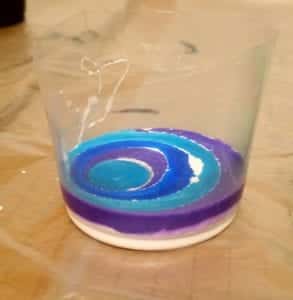
For the sample painting shown, I used the following percentage of each color in my three ounce pour cup:
30 percent Titanium White
20 percent Silver
20 percent Mars Black
10 percent Aquamarine
10 percent Sapphire
10 percent Amethyst
Paint the canvas
- Add a small thin puddle of white paint to the center of the canvas (this will help your colors spread)
- Lay your canvas upside down on top of your cup
- Flip both the cup and canvas over so the cup is now upside down on top of your canvas
- Leave cup upside down for around 60 seconds to allow cells to form and paints to settle
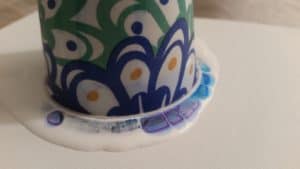
- Slowly remove cup

- Allow paints to sit for 60 seconds again
- Start tilting your canvas to spread the paint and cover the entire surface
- Once finished covering the canvas place it on top of the 4 cups to dry. Let it dry for 72 hours before moving, and at least a couple weeks before sealing to allow it to cure.
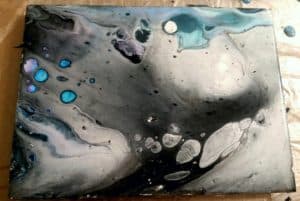
You did it! You created your first acrylic pour painting! If you want more tutorials and recipes check these resources out:
- Paint Pouring Tips for Beginners
- How to do an Acrylic Pour Swipe

- Guide to Acrylic Dirty Pour
- How to do a Rainbow Swipe Pour
If you’re interested in learning more and getting more step by step detailed instructions then get our Paint pouring beginners ebook.
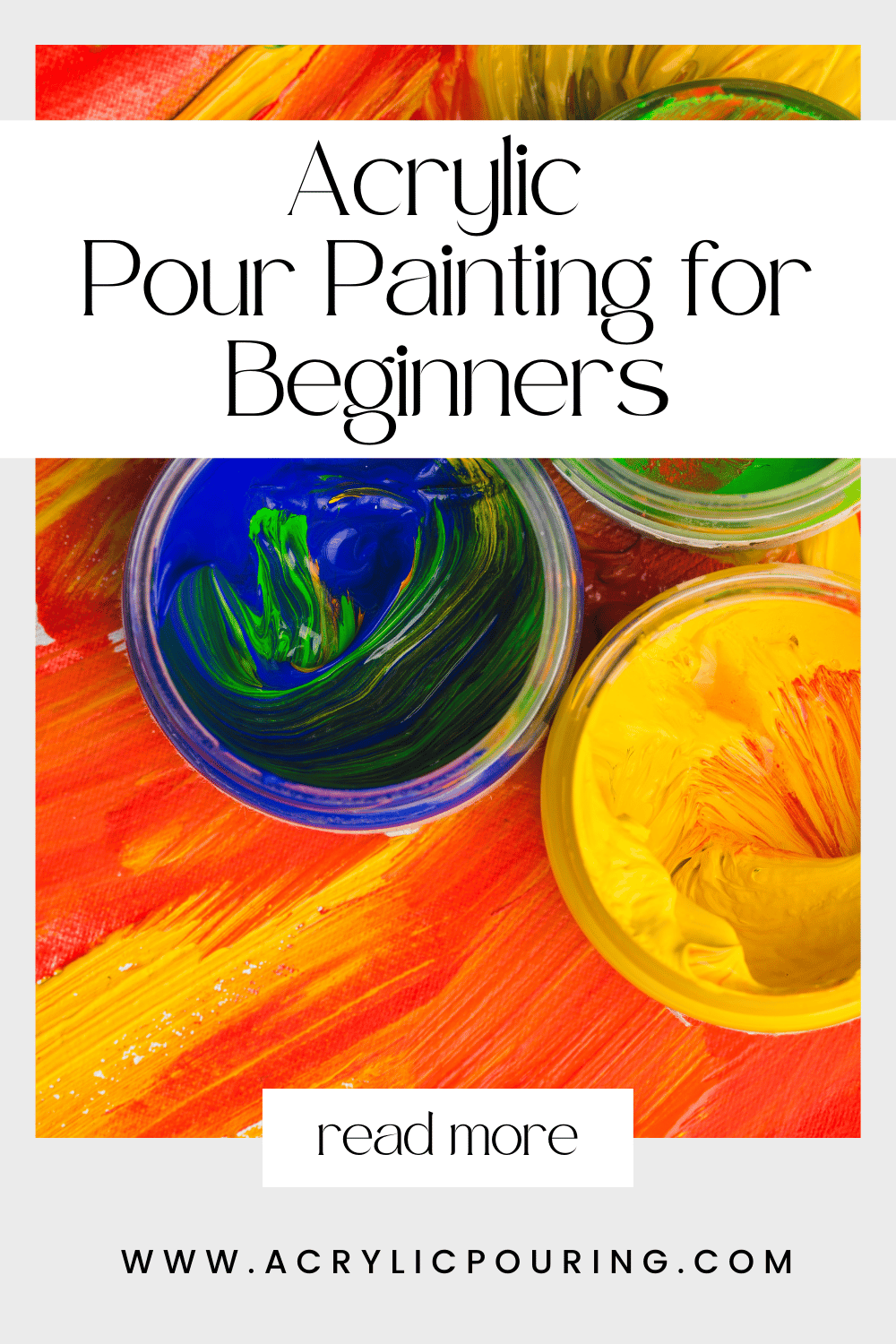
If you’re more of a video learner, then check out our paint pouring video course. And if you’re more interested in trying varied types of pours then try out our paint pouring recipe book.
See– not too complicated! Now you can give flip cup, swiping or any of those other aforementioned beginner techniques a try. Start simple and work your way through the beginner techniques, experimenting with new paints, mediums and surfaces along the way. There is nothing set in stone with fluid art; create your own techniques and let your creativity run wild.
Happy Pouring!

Sara Wagner is an author and artist from Upstate New York. She is the owner of Studio Blackwater and can typically be found covered in paint, cats, or her two young daughters. You can find her on Facebook and Instagram as @studioblackwater.

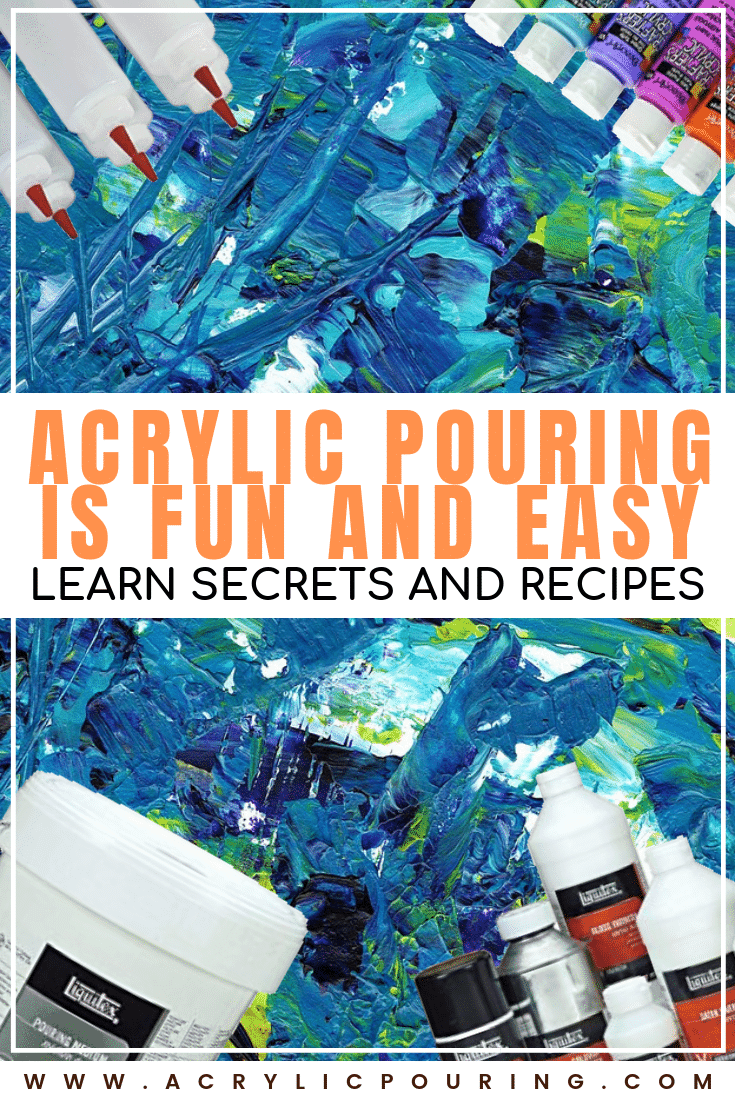


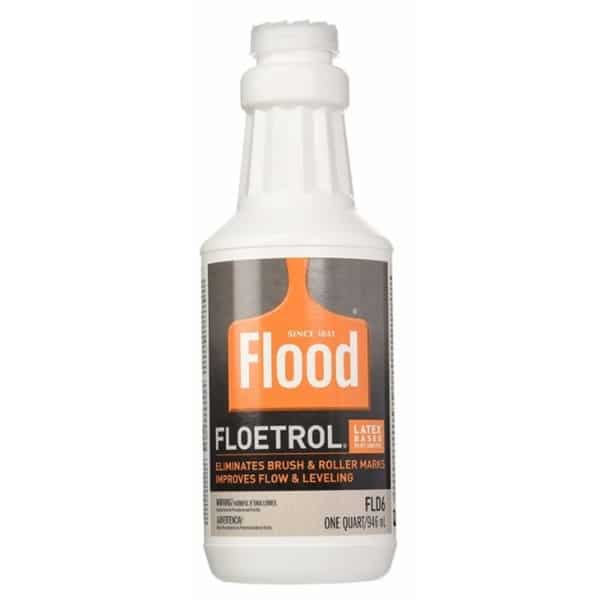
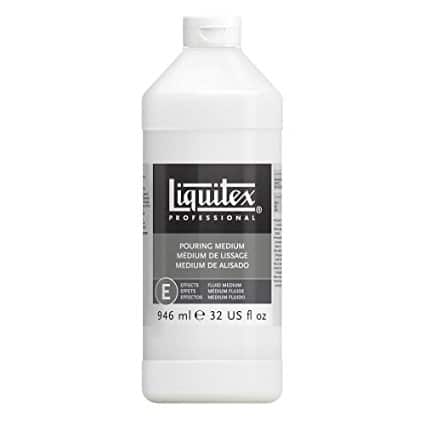
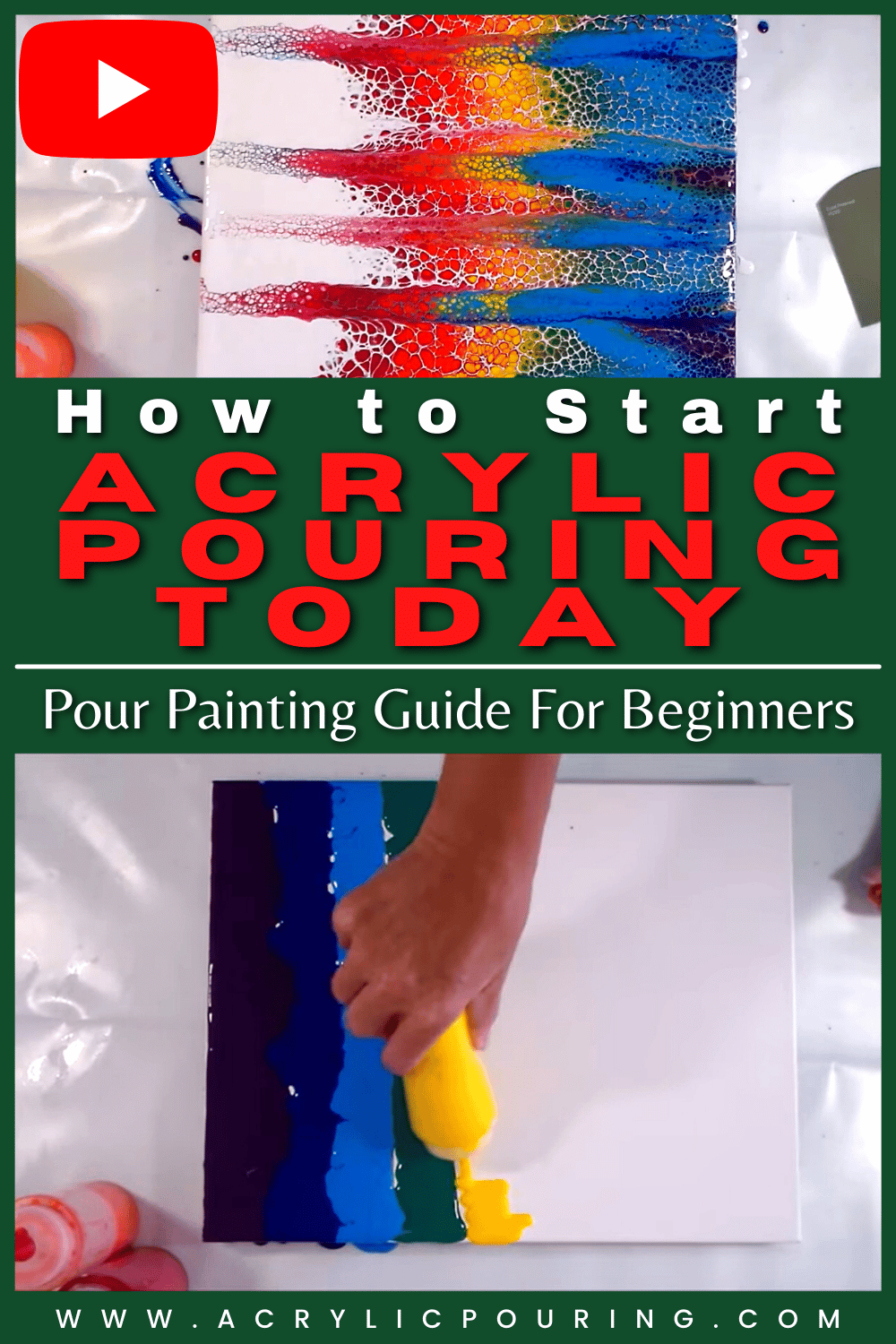
I’ve been observing this type of Art for some time now and it intrigues me more and more each time I watch and Artist’s are always inventing new ways to make this medium interesting. Finally, this summer I’m getting started myself and who knows, I might even come up with something NEW!!
Pastor Alan Wilson
I am a complete novice, trying to learn before pouring so as to reduce the learning curve a bit. I’ve seen reference to Floetrol here a couple of times but in reversed ratios….1:2 floetrol to paint and 1:2 paint to floetrol. Does it just depend on the type of paint used? I’ve seen some artists use as much as 4:1 floetrol to paint! Also everyone seems to use the Artist’s Loft Titanium White…..how is that different from their basic white? I bought a LOT of the basic, thinking that was what I needed for my base but now wondering if I got the wrong thing?
Super interesting and very helpful article! Thank you
Great website for learning, thanx for sharing information.
Penkraft is a great place to learn everything about art and craft. you can become a penkraft certified teacher. Penkraft provides you Handwriting Improvement, Calligraphy, ethnic art, modern art, phonic abacus, and vedic art.
Best information I have found anywhere!